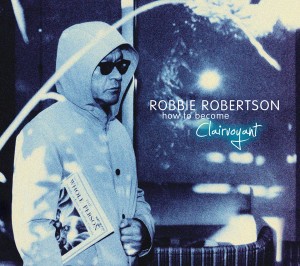Home » Jazz Articles » Album Review » Robbie Robertson: How To Become Clairvoyant
Robbie Robertson: How To Become Clairvoyant
Since the original Band broke up—its final days together in 1976 documented in director Martin Scorsese's 1978 film and concert recording of the same name, The Last Waltz (Warner Bros., 1978)—Robertson has largely busied himself with film work, most notably working on soundtracks to Scorsese films including 1983's The King of Comedy, 2010's Shutter Island. He has also released a handful of solo albums, the most successful being Robbie Robertson (Geffen Records, 1987).
On How to Become Clairvoyant, Robertson's first solo CD in ten years, he sings, "I do not play, no rock and roll," in that distinctive, whispering growl that sounds as if it's simmering just a half notch below bursting. It's a repeated claim in the opening cut, "Straight Down the Line," words from the mouths of story teller Robertson's characters: an old bluesman in a striped suit, a black-robed gospel choir singer. It has to come from his characters, because Robertson surely plays some rock and roll, with a crunchy Neil Young-like rhythm guitar grumbling beneath snapping, stinging single notes, all in front of a whomping, wall-shaking beat. Rock and roll, indeed.
The sound settles into a folksier groove with "When the Night Was Young," a tune that celebrates his youth, and a generation that could "save the world and stop the war," at a time of sharing the back roads with "tent show evangelists, card sharks, grifters and Luke the Drifter." As he did on the best of The Band's songs, Robertson—with his modern, carefully-crafted sound and quintessentially America characters—creates moods and paints surreal back alley images.
"He Don't Live Hear No More" rocks hard, sounding like a U2 collaboration with its dense, driving rhythm supplied, in large part, by the big explosive sound of the set's primary drummer, Ian Thomas. Guitarist Eric Clapton joins in on "The Right Mistake," an eerily laidback tune with some tasty background vocals and concise guitar licks crackling inside Steve Winwood's bubbly organ. Clapton's back on "Fear of Falling," having co-written the tune with Robertson, and his smooth and mellifluous voice contrasts Robertson's grit. Winwood is back, too, his organ whispering around the voices, and some acoustic guitar work that brings back memories of Clapton's days with Delaney & Bonnie & Friends.
In the world of rock music, Robertson has few peers in the shaping of atmospheres and moods, and telling stories with his songs. Another line from "Straight Down the Line" says, "Some things have tradition, some shine like new." Both claims could be made for How to Become Clairvoyant.
Track Listing
Straight Down the Line; When the Night Was Young; He Don't Live Here No More; The Right Mistake; This Is Where I Get Off; Fear of Falling; She's Not Mine; Madame X; Axman; Won't Be Back; How to Become Clairvoyant; Tango for Django.
Personnel
Robbie Robertson
guitarRobbie Robertson: guitar, keyboards, vocals; Dana Glover: backing vocals (1, 11); Robert Randolph: pedal steel guitar (1, 11); Pino Pallindino: bass; Ian Thomas: drums; Angela McCluskey: vocal (2); Angleyna Boyd: backing vocals (2, 4, 5); Daryl Johnson: backing vocals (2, 3, 5); Rocco Deluca: backing vocals (2, 3, 5, 7, 9); Taylor Goldsmith: backing vocals (2, 6, 9); Martin Pradler: Wurlitzer piano ( 2); Michelle John: backing vocals (4, 5); Marius DeVries: keyboards (3, 4, 5, 7, 10, 11, 12); Eric Clapton: guitar (3-8, 10), vocals: (6); Steve Winwood: organ (4, 6, 7); Bill Dillon: guitar, guitargan (4); Sharon White: backing vocal (4, 5); Trent Reznor: additional textures (8); Jim Keltner: drums (7) ; Tom Morello: guitar (9); Eldad Guetta: horns (10);Frank Morocco: accordion: (12); Anne Marie Calhoun: violin (12); Tina Guo: cello (12).
Album information
Title: How To Become Clairvoyant | Year Released: 2011 | Record Label: Macrobiotic Records
< Previous
Take Five With Mike Prigodich
Comments
About Robbie Robertson
Instrument: Guitar
Related Articles | Concerts | Albums | Photos | Similar ToTags
For the Love of Jazz
 All About Jazz has been a pillar of jazz since 1995, championing it as an art form and, more importantly, supporting the musicians who create it. Our enduring commitment has made "AAJ" one of the most culturally important websites of its kind, read by hundreds of thousands of fans, musicians and industry figures every month.
All About Jazz has been a pillar of jazz since 1995, championing it as an art form and, more importantly, supporting the musicians who create it. Our enduring commitment has made "AAJ" one of the most culturally important websites of its kind, read by hundreds of thousands of fans, musicians and industry figures every month.




















